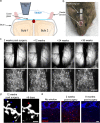Long-term imaging reveals dynamic changes in the neuronal composition of the glomerular layer
- PMID: 21632918
- PMCID: PMC6622877
- DOI: 10.1523/JNEUROSCI.0782-11.2011
Long-term imaging reveals dynamic changes in the neuronal composition of the glomerular layer
Abstract
The mammalian olfactory bulb (OB) contains a rich and highly heterogeneous network of local interneurons (INs). These INs undergo continuous turnover in the adult OB in a process known as "adult neurogenesis." Although the overall magnitude of adult neurogenesis has been estimated, the detailed dynamics of the different subpopulations remains largely unknown. Here we present a novel preparation that enables long-term in vivo time-lapse imaging in the mouse OB through a chronic cranial window in a virtually unlimited number of sessions. Using this preparation, we followed the turnover of a specific neuronal population in the OB, the dopaminergic (DA) neurons, for as long as 9 months. By following the same population over long periods of time, we found clear addition and loss of DA neurons in the glomerular layer. Both cell addition and loss increased over time. The numbers of new DA cells were consistently and significantly higher than lost DA cells, suggesting a net increase in the size of this particular population with age. Over a 9 month period of adult life, the net addition of DA neurons reached ∼ 13%. Our data argue that the fine composition of the bulbar IN network changes throughout adulthood rather than simply being replenished.
Figures



References
-
- Adam Y, Mizrahi A. Circuit formation and maintenance–perspectives from the mammalian olfactory bulb. Curr Opin Neurobiol. 2010;20:134–140. - PubMed
-
- Baker H, Morel K, Stone DM, Maruniak JA. Adult naris closure profoundly reduces tyrosine hydroxylase expression in mouse olfactory bulb. Brain Res. 1993;614:109–116. - PubMed
-
- Bhatt DH, Zhang S, Gan WB. Dendritic spine dynamics. Annu Rev Physiol. 2009;71:261–282. - PubMed
Publication types
MeSH terms
Substances
LinkOut - more resources
Full Text Sources
Miscellaneous
